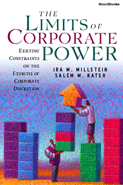
|
The Limits of Corporate Power: Existing Constraints on the
Exercise of Corporate Discretion
By Ira M. Millstein and Salem M. Katsh
2003/09 - Beard Books
1587982021 - Paperback - Reprint - 288 pp.
US$34.95
Millstein and Katsh provide an insightful discussion of the effects of social
forces on corporate conduct, such as public opinion and special interest groups.
Publisher Comments
The central issue of this important book is corporate control-the forces that serve to constrain the discretionary acts of business corporations-as important today as they were in 1980, when this book first appeared. Providing a valuable historic perspective, the authors focus on five different forces, specifying the controlling theory within each area and reviewing the mechanism of regulation.
First are the corporate chartering laws of the state limiting what the corporation does and how it does it. Then come the economic constraints-the forces of supply and demand operating through the market mechanism and the profit incentive, along with a thorough review of the antitrust and securities laws of the time. Third, the authors describe the constraints on corporate decision making (including incentives and penalties) imposed by the Federal tax system of that era. Additionally, they review the numerous controls in Federal and state regulatory statutes and administrative codes in force at the time.

From Bovis Kevitz
Dean, Graduate School of Business, Columbia University
"We have here a basic text for all serious students of the corporation and for all with sincere concern for its future."
From Book News, Inc.:
Written in 1981, this text examined legal and economic constraints that limited corporate behavior in the United States at that time. The authors look at state and federal charter laws, as well as other legal constraints on corporation creation and structure. They then examine antitrust and security laws. The federal tax system and direct regulation are each accorded separate chapters. The final chapter looks at the influence of social values imposed by various actors. Given that this book was written before an unprecedented wave of deregulation and a major increase in corporate power, it is now primarily of historical interest. Annotation ©2004

 Ira
M. Millstein is Senior Partner in the international law firm Weil, Gotshal & Manges LLP, where in addition to practicing in the areas of government regulation and antitrust law, he has counseled the boards of numerous large corporations on the issues of corporate governance. He is chairman of the Board of Advisors of the International Institute for Corporate Governance and the first Eugene F. Williams, Jr. Visiting Professor in Competitive Enterprise and Strategy at the Yale School of Management. Ira
M. Millstein is Senior Partner in the international law firm Weil, Gotshal & Manges LLP, where in addition to practicing in the areas of government regulation and antitrust law, he has counseled the boards of numerous large corporations on the issues of corporate governance. He is chairman of the Board of Advisors of the International Institute for Corporate Governance and the first Eugene F. Williams, Jr. Visiting Professor in Competitive Enterprise and Strategy at the Yale School of Management.
 Salem M. Katsh, head of the Intellectual Property Group at Shearman and Sterling, joined the firm as a partner in 1997. He is an experienced trial lawyer whose practice focuses on patent, trade secret, trademark, unfair competition, and antitrust litigation. Formerly at Weil, Gotshal & Manges, he was founder and co-head of the Patent and Technology Litigation Group, one of the first patent-oriented
pradctice groups to be formed at a major general practice law firm. Salem M. Katsh, head of the Intellectual Property Group at Shearman and Sterling, joined the firm as a partner in 1997. He is an experienced trial lawyer whose practice focuses on patent, trade secret, trademark, unfair competition, and antitrust litigation. Formerly at Weil, Gotshal & Manges, he was founder and co-head of the Patent and Technology Litigation Group, one of the first patent-oriented
pradctice groups to be formed at a major general practice law firm.

|
Foreword |
ix |
| Acknowledgments |
xii |
| Introduction |
xv |
| Chapter 1. Organic State and Federal
Constraints Relating to the Creation, Structure and Management of the
Business Corporation |
1 |
|
State Law |
|
|
Regulatory Approaches / Corporate
Formalities / Recent Procedural Trends / Duties of Loyalty, Care, and
Fairness / Recent Limitations on the Scope of the Business Judgment
Rule |
|
| Federal Law |
|
|
Regulatory Approach / Proxy Regulation /
"Negative Disclosure" Requirements / Corporate Governance |
|
| Chapter 2. The Economic Constraints Imposed
on Corporate Decision Making by the Free Market System and the Antitrust
and Securities Laws |
23 |
|
The System of Market Constraints |
|
|
The Market System -- An Overview / The
Principal Elements of the Market System |
|
| Legal Regulations Designed to Preserve the
System of Market Constraints |
|
|
The Antitrust Laws / The Securities Laws |
|
| Chapter 3. The Federal Tax System as a
Constraint Upon Corporate Decision Making |
87 |
|
Capital Raising through Debt and Equity |
|
| Corporate Acquisitions |
|
|
Use of Debt versus Equity in
Acquisitions / Incentives to Corporate Combinations |
|
| Capital Investment and Special Expenditures |
|
|
Internal Development through Advertising
or R&D / Investment in Depreciable Tangible Personal Property /
Investment in Real Property / Investment in Selected Types of Property:
Pollution Control, Energy, Transportation and Natural Resources /
Investment in the Creation of New Technology / Relation to Antitrust
Policy / Donations to Charities and Political Candidates and Expenses to
Influence Public Opinion |
|
| Employment |
|
|
Hiring of Selected Types of Employees /
Providing Selected Types of Benefits to Employees / Retirement
Arrangements |
|
| International Operations |
|
|
Foreign versus Domestic Investment /
Regulation of Offshore Activity through the Tax System |
|
| Chapter 4. The Constraining Effect of
Direct Regulation on the Corporate Decision-Making Process |
125 |
|
Theories of Regulation |
|
|
Economic Regulation / Regulation of
"Externalities" / Preclearance / Licenses and Allocations /
Disclosures / Social Regulations |
|
| Illustrative Regulatory Programs |
|
|
Regulation of Labor Relations, Equal
Employment Opportunity, and Employee Working Conditions / Federal
Environmental Regulation / Consumer Protection Regulation / Regulation
of Political Activities / Energy Regulation |
|
| Chapter 5. The Constraining Influence of
Social Values on Corporate Decision Making |
229 |
|
Public Opinion and News and Broadcast Media |
|
| Industry Associations |
|
| Employees |
|
| Shareholders and Institutional Investors |
|
| The "Intellectual Community" |
|
| Public Interest Groups |
|
|
Environmental and Energy Interest Groups
/ Consumer Interest Groups / Civil Rights Groups / General Public
Interest Organizations |
|
| Government Threats and Persuasion |
|
|
Executive Branch "Jawboning" /
Legislative and Regulatory "Posturing" |
|
| Legal Counsel, Auditors, and Other
Professionals |
|
| Index |
259 |
|

 Ira
M. Millstein is Senior Partner in the international law firm Weil, Gotshal & Manges LLP, where in addition to practicing in the areas of government regulation and antitrust law, he has counseled the boards of numerous large corporations on the issues of corporate governance. He is chairman of the Board of Advisors of the International Institute for Corporate Governance and the first Eugene F. Williams, Jr. Visiting Professor in Competitive Enterprise and Strategy at the Yale School of Management.
Ira
M. Millstein is Senior Partner in the international law firm Weil, Gotshal & Manges LLP, where in addition to practicing in the areas of government regulation and antitrust law, he has counseled the boards of numerous large corporations on the issues of corporate governance. He is chairman of the Board of Advisors of the International Institute for Corporate Governance and the first Eugene F. Williams, Jr. Visiting Professor in Competitive Enterprise and Strategy at the Yale School of Management.